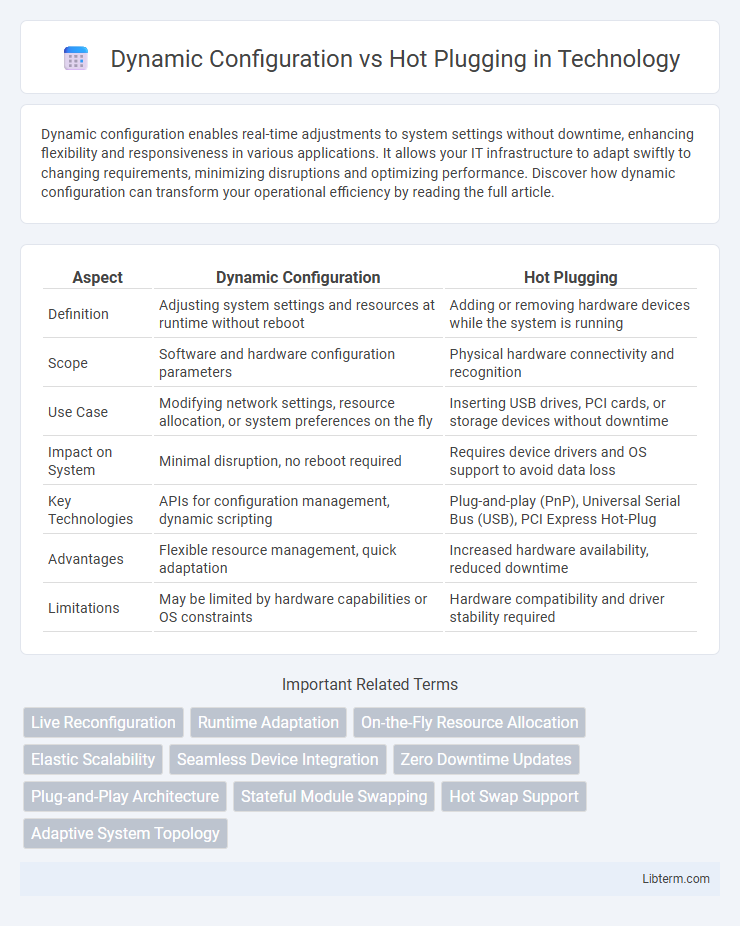Dynamic configuration enables real-time adjustments to system settings without downtime, enhancing flexibility and responsiveness in various applications. It allows your IT infrastructure to adapt swiftly to changing requirements, minimizing disruptions and optimizing performance. Discover how dynamic configuration can transform your operational efficiency by reading the full article.
Table of Comparison
| Aspect | Dynamic Configuration | Hot Plugging |
|---|---|---|
| Definition | Adjusting system settings and resources at runtime without reboot | Adding or removing hardware devices while the system is running |
| Scope | Software and hardware configuration parameters | Physical hardware connectivity and recognition |
| Use Case | Modifying network settings, resource allocation, or system preferences on the fly | Inserting USB drives, PCI cards, or storage devices without downtime |
| Impact on System | Minimal disruption, no reboot required | Requires device drivers and OS support to avoid data loss |
| Key Technologies | APIs for configuration management, dynamic scripting | Plug-and-play (PnP), Universal Serial Bus (USB), PCI Express Hot-Plug |
| Advantages | Flexible resource management, quick adaptation | Increased hardware availability, reduced downtime |
| Limitations | May be limited by hardware capabilities or OS constraints | Hardware compatibility and driver stability required |
Introduction to Dynamic Configuration and Hot Plugging
Dynamic configuration allows systems to modify hardware or software settings on-the-fly without requiring shutdown, improving flexibility and uptime. Hot plugging specifically refers to the ability to add or remove hardware components such as USB devices or PCI cards while the system remains powered on and operational. Both techniques enhance system adaptability and maintenance efficiency by minimizing downtime and supporting real-time adjustments.
Defining Dynamic Configuration
Dynamic configuration allows systems to adapt hardware or software settings in real-time without requiring a shutdown or reboot, enhancing operational flexibility. It involves automatic detection and adjustment of resources, such as memory allocation or device parameters, to optimize performance based on current workloads. This contrasts with hot plugging, which specifically refers to the physical insertion or removal of components while the system is running.
Understanding Hot Plugging
Hot plugging enables the addition or removal of hardware components without shutting down the system, allowing seamless hardware upgrades and replacements. This real-time hardware management is critical for maintaining system uptime and is commonly supported in modern operating systems and server environments. Understanding hot plugging involves recognizing its reliance on compatible hardware, firmware support, and dynamic resource allocation to ensure stable operation during component changes.
Key Differences Between Dynamic Configuration and Hot Plugging
Dynamic configuration allows the operating system to recognize and adapt to hardware changes during runtime, enabling devices to be added or removed without requiring a system reboot. Hot plugging specifically refers to the physical act of connecting or disconnecting hardware components while the system is powered on, often relying on dynamic configuration mechanisms for smooth detection and integration. Key differences include that dynamic configuration emphasizes system-level recognition and resource management, whereas hot plugging focuses on the hardware interface and physical connectivity without interrupting system operation.
Use Cases for Dynamic Configuration
Dynamic configuration enables real-time system adjustments without rebooting, ideal for cloud environments requiring rapid scaling and resource allocation. It supports scenarios like adding or removing network interfaces and updating storage volumes on active servers, enhancing flexibility and minimizing downtime. Dynamic configuration is essential in DevOps pipelines for continuous integration and continuous deployment (CI/CD) workflows, enabling seamless infrastructure changes during runtime.
Use Cases for Hot Plugging
Hot plugging is essential in scenarios requiring uninterrupted system operation, such as in server maintenance, where components like CPUs, memory modules, or storage drives are added or replaced without shutting down the system. It is widely used in data centers and cloud environments to enhance scalability, allowing hardware upgrades and replacements while preserving data integrity and minimizing downtime. Enterprise storage systems and high-availability computing infrastructures rely on hot plugging to maintain continuous service and improve operational efficiency.
Pros and Cons of Dynamic Configuration
Dynamic configuration enables real-time system adjustments without requiring hardware changes, enhancing flexibility and reducing downtime. It allows immediate updates to settings and resource allocations, optimizing system performance under varying workloads. However, it may introduce complexity in management and potential stability risks if configurations are improperly applied during operation.
Pros and Cons of Hot Plugging
Hot plugging allows hardware components to be added or removed without shutting down the system, enhancing flexibility and minimizing downtime. However, it can introduce risks such as potential data corruption, hardware incompatibility, and increased system complexity requiring robust support from the operating system and drivers. Despite these challenges, hot plugging is valuable in high-availability environments where continuous operation is critical.
Choosing the Right Approach: Factors to Consider
Choosing between dynamic configuration and hot plugging depends on system flexibility, downtime tolerance, and hardware compatibility. Dynamic configuration is ideal for environments requiring frequent, seamless updates without rebooting, whereas hot plugging suits hardware designed for safe insertion/removal during operation. Evaluating factors like system architecture, performance impact, and risk of hardware damage guides the optimal approach selection.
Future Trends in System Adaptability
Dynamic configuration enhances system adaptability by enabling real-time updates to hardware and software settings without system downtime, essential for next-generation IoT and edge computing environments. Hot plugging supports seamless integration and removal of devices, promoting modular architectures that allow rapid scaling and maintenance in cloud infrastructures. Emerging trends emphasize combining AI-driven predictive analytics with these capabilities to optimize resource allocation and minimize disruptions in highly dynamic systems.
Dynamic Configuration Infographic

 libterm.com
libterm.com